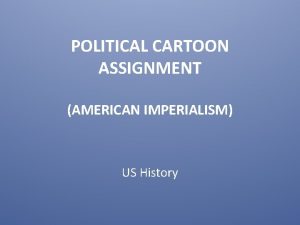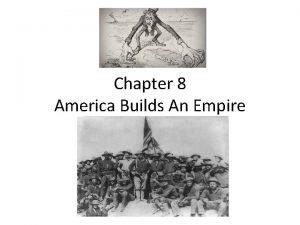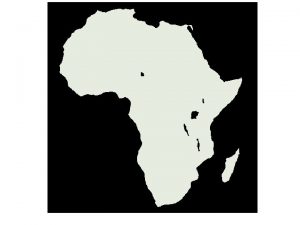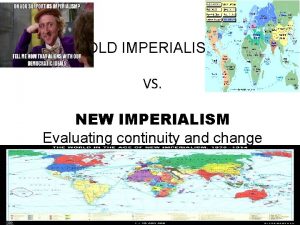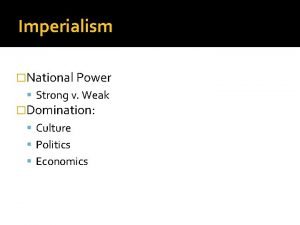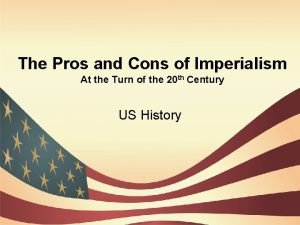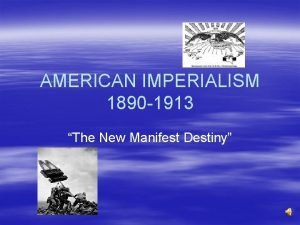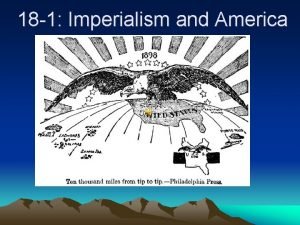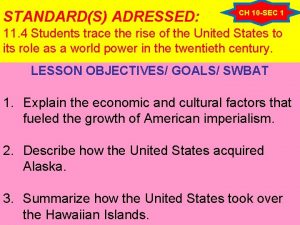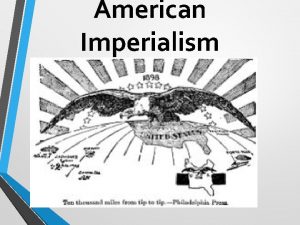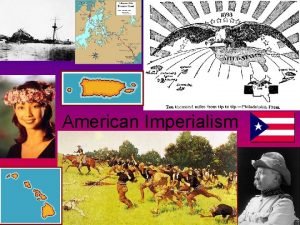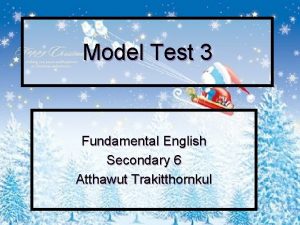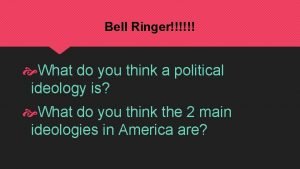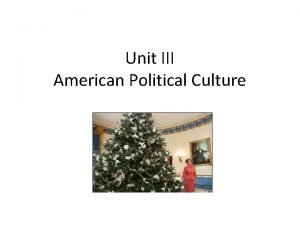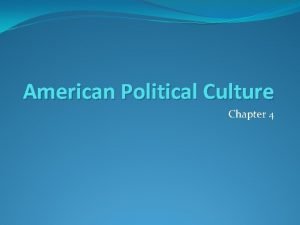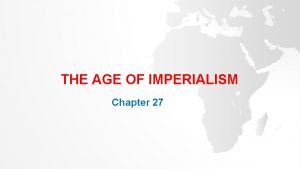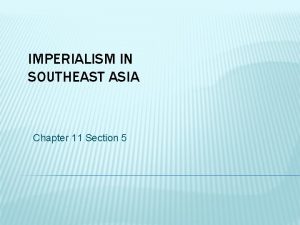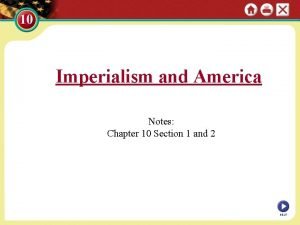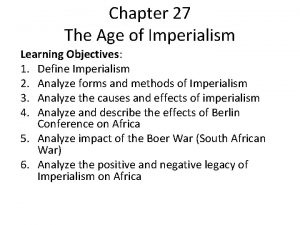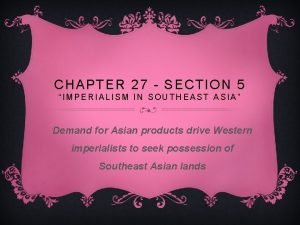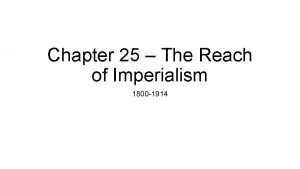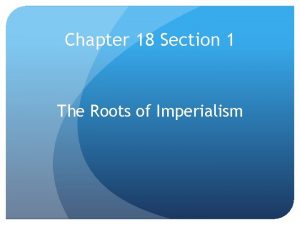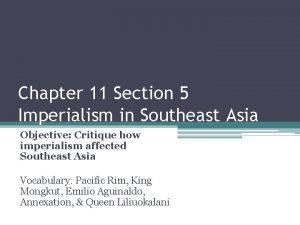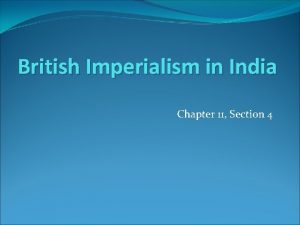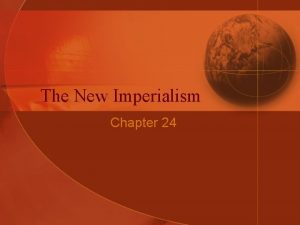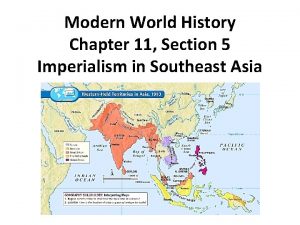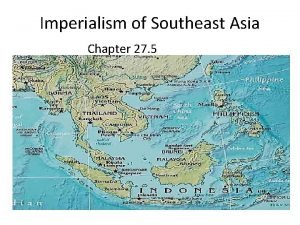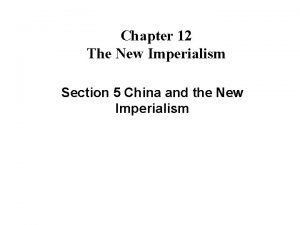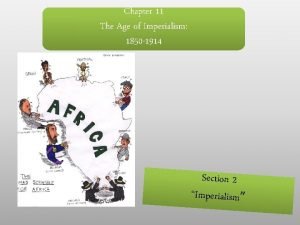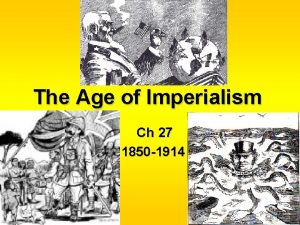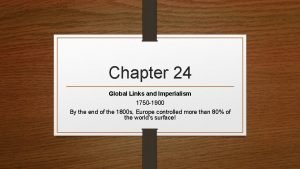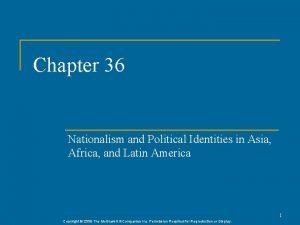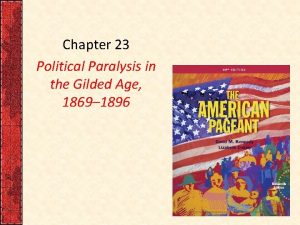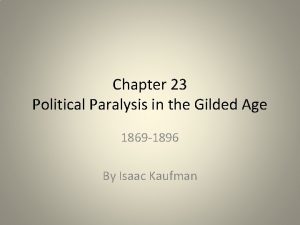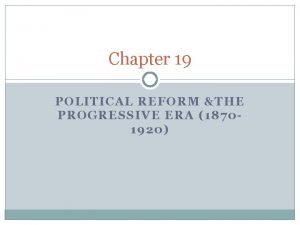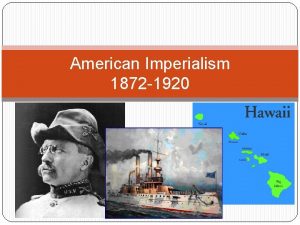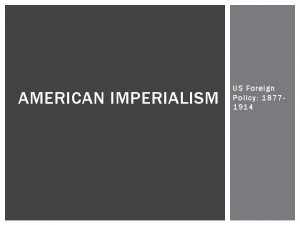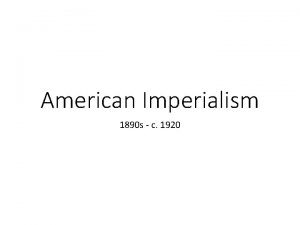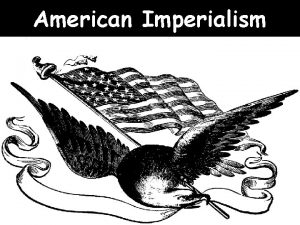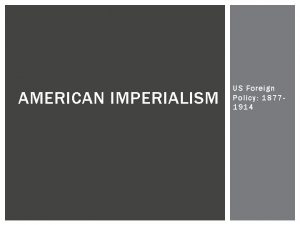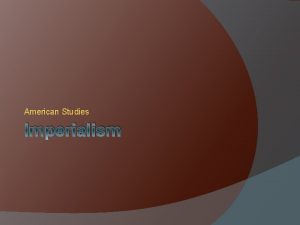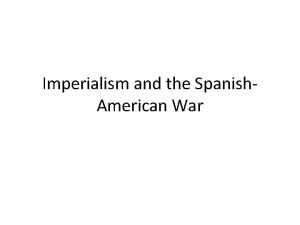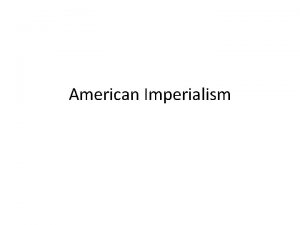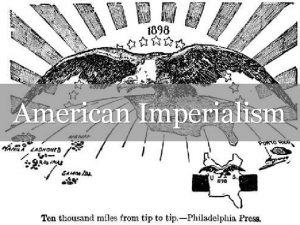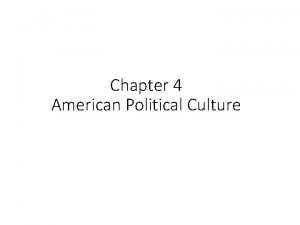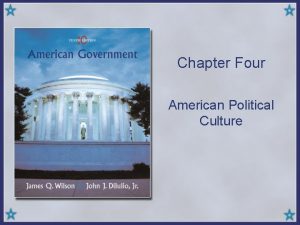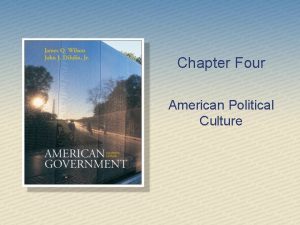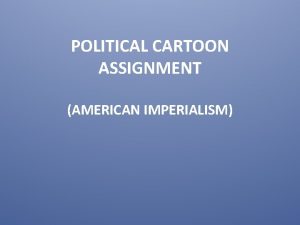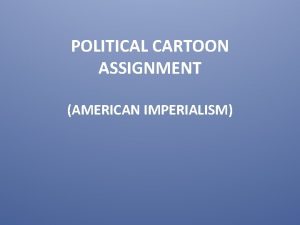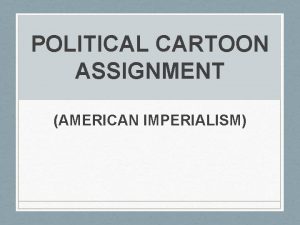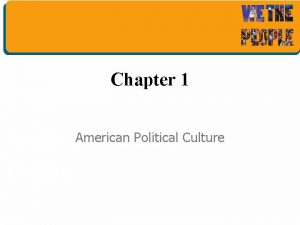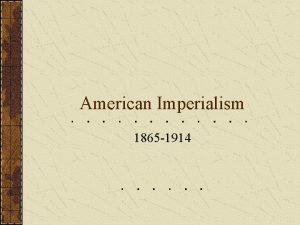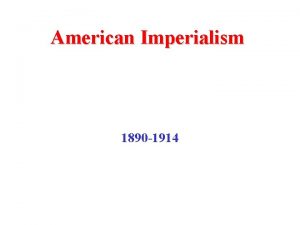American Imperialism Chapter 18 What is Imperialism political








































- Slides: 40

American Imperialism Chapter 18

What is Imperialism? political, military, and economic domination (complete control) of strong nations over weak territories


Why Imperialism? Economic Causes desire for raw materials & natural resources need for new markets for American exports – U. S. was producing more goods than Americans could consume

Why Imperialism? Political / Strategic Causes need to protect trade & U. S. interests abroad to strengthen U. S. navy; needed for refueling stations abroad (navy bases) USS Maine Launched in 1889, the USS Maine was a modernized steel-plated, steam-powered battleship.

The Spanish-American War

Causes of the Spanish-American War People of Cuba & Philippines wanted to rebel against Spain Depression of 1890 in Cuba; 1895 Cubans revolted against Spain Spanish used harsh tactics against Cubans (Gen. Valeriano “the Butcher” Weyler) “The Butcher” Weyler American press (“yellow journalism”) reported cruelties; Pulitzer & Hearst created sympathy for Cubans American investments & property destroyed during Cuban revolt Joseph Pulitzer, journalist for New York World

America Declares War Feb 9, 1898 – De. Lome Letter printed in Hearst’s Journal – called Mc. Kinley weak & stupid Feb 15, 1898 – USS Maine exploded in Havana harbor killing 266 American sailors; press blamed Spain - “War? Sure!” Mc. Kinley asked Congress to declare war April 19, Congress declared war & adopted Teller Amendment – US had no intention of annexing

“A Splendid Little War” Rough Riders War fought on 2 fronts: Caribbean (Cuba & P. R. ) Pacific (Philippines) Commodore George Dewey led the naval destruction of Spanish fleet in Manila Bay, Philippines in May 1898; by Aug. Spanish troops surrendered U. S. troops land in Cuba by June; T. Roosevelt led Rough Riders in Cuba – charged up San Juan Hill which opened way into Santiago harbor Spanish-American War: Apr 25 - Aug 12, 1898;


Treaty of Paris, 1898 1. Spain recognized Cuban independence (would become a U. S. protectorate) 2. U. S. paid Spain $20 mill. to give up the Philippines 3. Guam (Pacific) and Puerto Rico ceded to the U. S. Guam still U. S. possession; Puerto Rico is a commonwealth

Effects of the Spanish American War U. S. recognized as a world power & acquired an overseas empire (leads to debate over expansion) U. S. annexation of Philippines led to Philippine- American War led by Emilio (3 years; 216, 000 Filipinos died & 5, 000 Americans) 1946 - Philippines given independence U. S. made Cuba a “protectorate” (Platt Amendment added to Cuba’s constitution) & soon gave Cuba independence

Work on this… Spanish-American War Review… Index Card: List or draw 2 causes & 1 effect of the war Spanish-American War Causes & Effects

Debate over Expansion: Should U. S. annex Philippines Imperialists supported expansion Arguments: 1. Americans needed new frontier 2. New markets for American manufactured goods 3. New sources of raw materials 4. Increase in military power 5. Spread American ideals: Christianity, democracy, capitalism 6. American superiority – our “duty”

Debate Over Expansion: Should U. S. annex Philippines? Anti-imperialists opposed expansion Arguments: 1. Rejected nation’s foundation of “liberty for all” 2. Faced enough difficulties at home 3. Threatened democratic foundations (fear of large standing armies) 4. Racism – might have to absorb people of different races 5. Expansion would cost too much 6. Fear of competition in job market; lower wages

New Lands Come Under U. S. Flag Hawaii (1891) U. S. annexed after queen was deposed by a wealthy planter Sanford Dole & U. S. Marines Guam (1898) Treaty of Paris, 1898 Puerto Rico (1898) Treaty of Paris, 1898 Midway Islands (1867) U. S. occupied & annexed – for naval base Alaska (1867) U. S. purchased from Russia for $7. 2 million (“Seward’s Folly, ” “Seward’s Icebox”) Samoa (1899) U. S. acquired base at Pago Philippines (1898) Treaty of Paris, 1898





Panama Canal Who: Theodore Roosevelt What: waterway linking Atlantic and Pacific Oceans; greatly reduced travel time between U. S. coastlines When: construction began 1904; finished in 1914 Why: for commercial and strategic advantages; facilitated trade; alternative to needing separate navies for each ocean (page 606 – 607)

How Did U. S. Acquire Rights to Build the Canal? Hay-Bunau-Varilla Treaty signed with Panama in 1904 Panama Canal Timeline: 1) 1903: U. S. negotiated treaty w/ Colombia (Panama part of) 2) Colombian gov’t stalled treaty demanding more money 3) Roosevelt impatient – supported Panama’s revolt 4) U. S. recognized Panama’s independence, negotiated treaty w/ Panama ($10 mill; $250, 000 yearly lease for

Panama Canal Today 1978 Panama Canal Treaty negotiated during Jimmy Carter’s Presidency; canal gradually transitioned to Panama’s control Transition completed in 2000 – Panama owns and operates canal today

Lets Review for the Monroe https: //www. youtube. com/watc h? v=m. FNg. Y 9 Bd. VRk

Background: The Monroe Doctrine -1823 • America believed they were in charge/boss of Latin “No more European America. colonization in the No more • This had first started in the Western Hemisphere” European early 1800 s. “No intervention from colonization in • President James Monroe Europe if their had issued a proclamation to the Western Europe called “Monroe American colonies Hemisphere. Doctrine” wanted their independence. ”

Review: What is the Monroe Doctrine? Issued by President Monroe in 1823 We (United States) won’t bother you (Europe), you don’t bother us (Western Hemisphere)

Roosevelt Corollary (To Monroe Doctrine) Why? Europeans threatened intervention in W. Hemisphere (to collect debts, etc. ) When and how stated? In Dec. 1904 by Roosevelt in message to Congress Central Message: if intervention in W. Hemisphere necessary, U. S. would intervene, not

Roosevelt Corollary When / Where / How Tested? Early 1900’s in Dominican Republic, Nicaragua, Haiti, Virgin Islands – U. S. used various methods of intervention Significance / Effect on U. S. – Latin American Relations: Made U. S. the international police power in W. Hemis. ; led to U. S. intervention; damaged relations w/ Latin American nations

Monroe Doctrine and Roosevelt Corollary Read the Roosevelt Corollary handout Compare and Contrast the Monroe Doctrine to the Roosevelt Corollary You Choose How to do it! (Choose 1) Make a T chart Make a Venn Diagram Create a Political Cartoon Write a paragraph

Latin America Diplomacy What does the word “diplomacy” mean? managing or negotiating with other countries Roosevelt’s Big Stick Diplomacy Taft’s Dollar Diplomacy Wilson’s Moral Diplomacy

Who is the man in the center Who do the people on the right represent? Left? Who is the “boss” in this picture?

“Speak Softly and Carry a Big Stick” - T. Roosevelt Old African proverb Describes Roosevelt’s foreign policy: - Use diplomacy, but have power to enforce it and protect American interests - Intervention if necessary - “big stick” = the U. S. navy

Taft’s “Dollar Diplomacy” Maintain orderly societies abroad by increasing American investment in foreign economies “Substituting “dollars for bullets” Taft’s foreign policy not as aggressive as Roosevelt’s

Wilson attempts a new direction: Moral Diplomacy 1912 Wilson criticized foreign policy under TR and Taft Wilson: promised US would not seek new territory but would work to promote “human rights, national integrity & opportunity” Still ordered interventions in Haiti, Dominican Republic & Mexico

List all that you see. Who does each of the figures represent? Write one word to describe each of the figures. What is this cartoon about?

Reasons for a Canal The U. S wanted to build a canal to save time It took 14, 000 miles to get around South America A canal would cut the

“I took the isthmus” Roosevelt wanted to build a canal through Panama which was part of Columbia refused Panamanians rebelled against Columbia U. S supported them with its navy and marines Within 2 weeks, the U. S and Panama made a treaty to create a canal This event most clearly demonstrates Roosevelt’s Big Stick Policy President Theodore Roosevelt at the groundbreaking of the Panama Canal

Roosevelt Corollary Added onto the Monroe Doctrine AKA: “Big Stick Policy”. TR said to the world: “You can’t interfere in Latin America … but we can!” America will be in charge/police the Western Hemisphere 1. Ask first and then use force (Big Stick Policy) 2. Use force if necessary

If social media existed when the Roosevelt Corollary was delivered, and a news reporter issued social media “shares” of the speech, which 3 direct quotes would be most "shared" on social media to the American people and why? What would be 3 interpretive/summary statements the reporter would write him or herself and then “share” to the American people and why? Write 2 responses by Britain to 1 of each type of the above shares. Write 2 responses by a Latin American country of your choice to 1 of each type of the above shares

Pair-Share Compare and contrast the Monroe Doctrine and the Roosevelt’s Big Stick Policy.
 American imperialism political cartoons explained
American imperialism political cartoons explained Describe the cartoon
Describe the cartoon America builds an empire
America builds an empire Old imperialism vs new imperialism chart
Old imperialism vs new imperialism chart New imperialism vs old imperialism
New imperialism vs old imperialism What is the message of this political cartoon?
What is the message of this political cartoon? Pros and cons of imperialism
Pros and cons of imperialism What three factors spurred american imperialism
What three factors spurred american imperialism Roots of american imperialism
Roots of american imperialism American imperialism definition
American imperialism definition The roots of american imperialism economic roots
The roots of american imperialism economic roots Expansionism
Expansionism American imperialism 1800s
American imperialism 1800s Alaska american imperialism
Alaska american imperialism Political demonstrations on american campuses have abated
Political demonstrations on american campuses have abated American political spectrum
American political spectrum American political culture definition
American political culture definition American political culture definition
American political culture definition Chapter 27 building vocabulary the age of imperialism
Chapter 27 building vocabulary the age of imperialism Imperialism in southeast asia chapter 11 section 5
Imperialism in southeast asia chapter 11 section 5 Chapter 10 section 1 imperialism and america
Chapter 10 section 1 imperialism and america Chapter 27 building vocabulary the age of imperialism
Chapter 27 building vocabulary the age of imperialism Imperialism in southeast asia chapter 27 section 5
Imperialism in southeast asia chapter 27 section 5 Chapter 25 lesson 1 colonial rule in southeast asia
Chapter 25 lesson 1 colonial rule in southeast asia Roots of imperialism
Roots of imperialism Chapter 11 section 5 imperialism in southeast asia
Chapter 11 section 5 imperialism in southeast asia Britain crown
Britain crown Chapter 24 section 5 china and the new imperialism
Chapter 24 section 5 china and the new imperialism Chapter 11 section 5 imperialism in southeast asia
Chapter 11 section 5 imperialism in southeast asia Chapter 27 section 5 imperialism in southeast asia
Chapter 27 section 5 imperialism in southeast asia Chapter 14 the height of imperialism
Chapter 14 the height of imperialism Chapter 12 section 5 china and the new imperialism
Chapter 12 section 5 china and the new imperialism Chapter 11 the age of imperialism
Chapter 11 the age of imperialism Chapter 27 the age of imperialism
Chapter 27 the age of imperialism Global links and imperialism
Global links and imperialism Chapter 10 building vocabulary america claims an empire
Chapter 10 building vocabulary america claims an empire Chapter 35 nationalism and political identities in asia
Chapter 35 nationalism and political identities in asia Chapter 36 nationalism and political identities in asia
Chapter 36 nationalism and political identities in asia Chapter 23 political paralysis in the gilded age
Chapter 23 political paralysis in the gilded age Political paralysis in the gilded age
Political paralysis in the gilded age Chapter 19 political reform and the progressive era
Chapter 19 political reform and the progressive era

